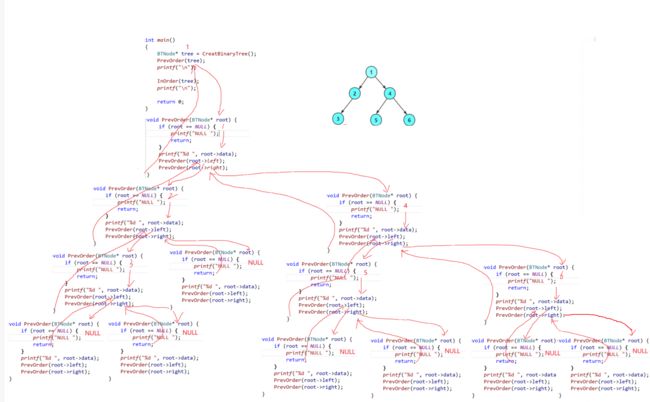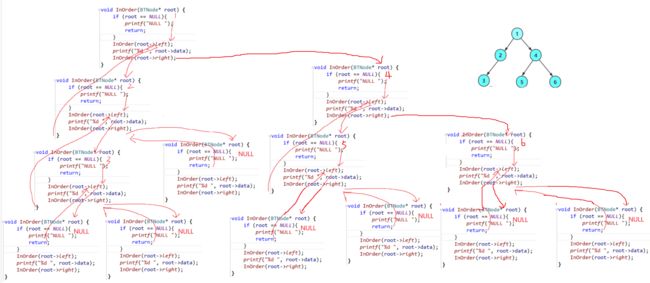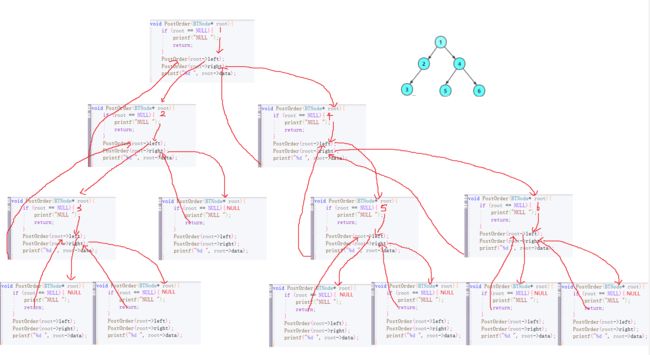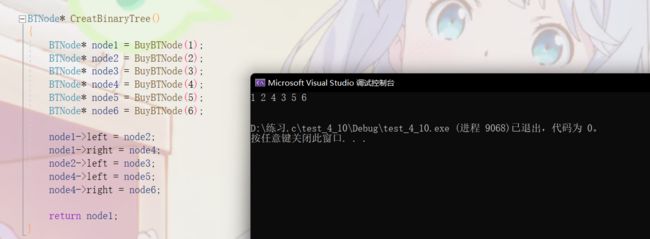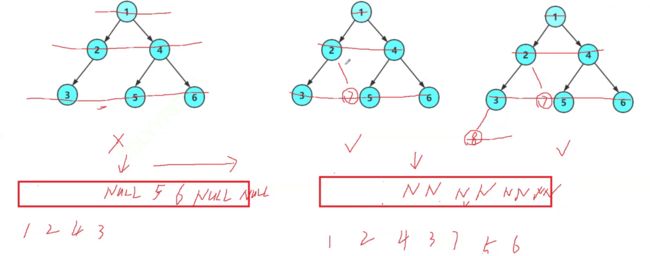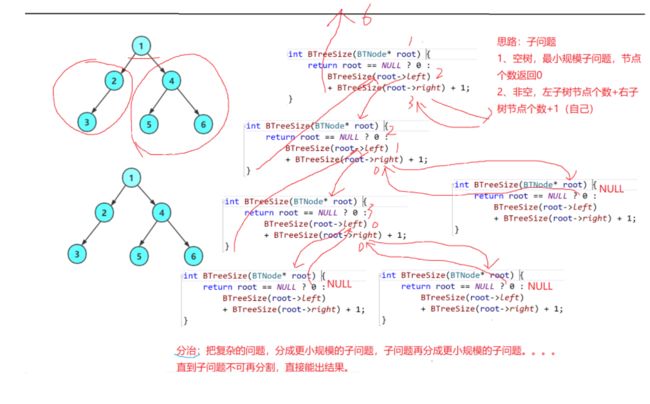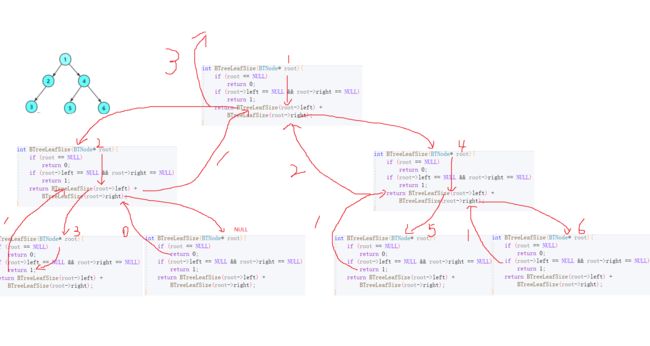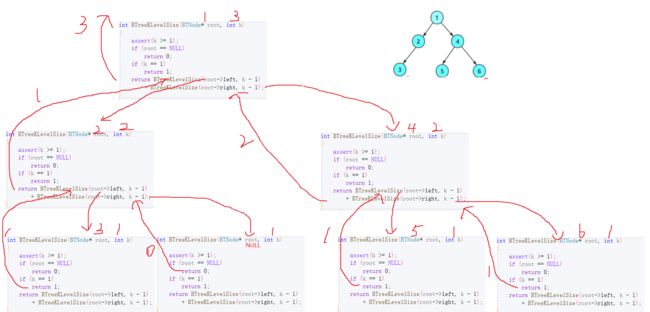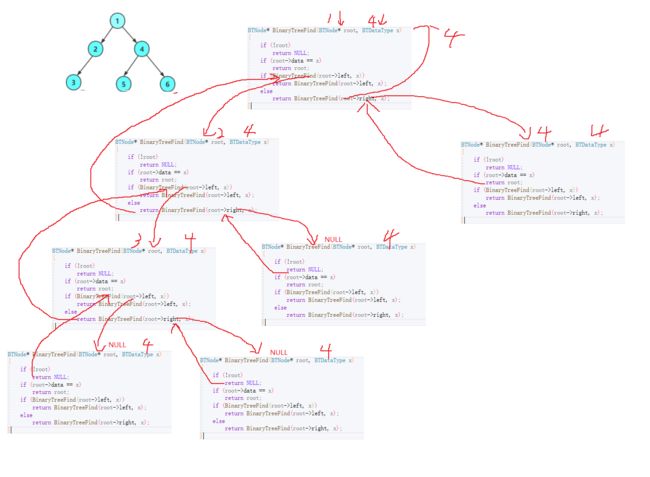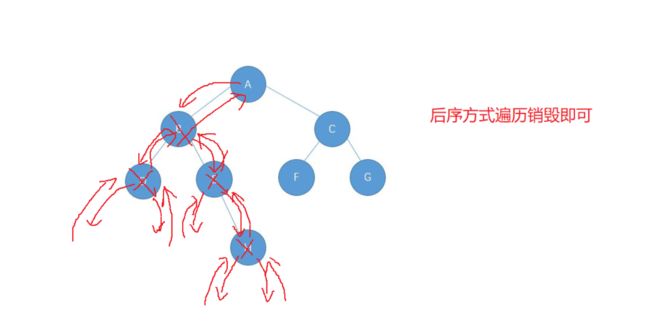二叉树的链式结构(C语言版)
攀登顶峰,这种奋斗的本身就足以充实人的心。
文章目录
- 1.前言
- 2二叉树的遍历
-
- 2.1 前序、中序以及后序遍历
- 2.2 前序代码演示及递归图解
- 2.3 中序代码演示及递归图解
- 2.4 后序代码演示及递归图解
- 2.5 层序遍历
- 2.6 判断一棵二叉树是否为完全二叉树
- 3 节点个数以及高度等
-
- 3.1 节点个数及递归图解
- 3.2 叶子节点个数及递归图解
- 3.3 第k层的节点数及递归图解
- 3.4 二叉树的深度及递归图解
- 3.5 二叉树查找值为x的节点及递归图解
- 3.6 二叉树的销毁
- 4.总结
1.前言
以前我们学习顺序表、链表和堆时,一上来就是学习它们的增删查改等接口函数,但是普通的链式二叉树的增删查改没有意义。如果是为了单纯存储数据,不如使用线性表。我们学习链式二叉树是为了更好地控制它的结构,为后续学习更复杂的搜索二叉树打基础,而且很多二叉树oj算法题都出在普通二叉树上。
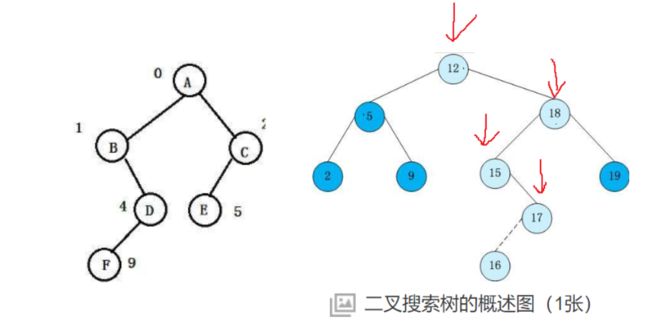
在学习二叉树的基本操作前,需先要创建一棵二叉树,然后才能学习其相关的基本操作。为了降低大家学习成本,此处手动快速创建一棵简单的二叉树,快速进入二叉树操作学习,等二叉树结构了解的差不多时,我们反过头再来研究二叉树真正的创建方式。
#include 注意:上述代码并不是创建二叉树的方式,真正创建二叉树方式后序详解重点讲解。
再看二叉树基本操作前,再回顾下二叉树的概念,二叉树是:
- 空树
- 非空:根节点,根节点的左子树、根节点的右子树组成的
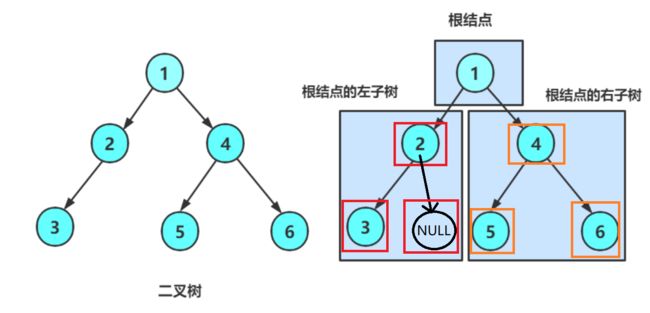
从图中可以看出根节点的左子树和右子树又可以被分为根、根的左子树、根的右子树。因此二叉树定义是递归式的,后序基本操作中基本都是按照该概念实现的。
2二叉树的遍历
2.1 前序、中序以及后序遍历
学习二叉树结构,最简单的方式就是遍历。所谓二叉树遍历(Traversal)是按照某种特定的规则,依次对二叉树中的节点进行相应的操作,并且每个节点只操作一次。访问结点所做的操作依赖于具体的应用问题。 遍历是二叉树上最重要的运算之一,也是二叉树上进行其它运算的基础。
按照规则,二叉树的遍历有:前序/中序/后序的递归结构遍历:
- 前序遍历(Preorder Traversal 亦称先序遍历)——访问根结点的操作发生在遍历其左右子树之前。
- 中序遍历(Inorder Traversal)——访问根结点的操作发生在遍历其左右子树之中(间)。
- 后序遍历(Postorder Traversal)——访问根结点的操作发生在遍历其左右子树之后。
由于被访问的结点必是某子树的根,所以N(Node)、L(Left subtree)和R(Rightsubtree)又可解释为根、根的左子树和根的右子树。NLR、LNR和LRN分别又称为先根遍历、中根遍历和后根遍历。

2.2 前序代码演示及递归图解
void PrevOrder(BTNode* root)
{
if (root == NULL)
{
printf("NULL ");
return;
}
printf("%d ", root->data);
PrevOrder(root->left);
PrevOrder(root->right);
}
2.3 中序代码演示及递归图解
void InOrder(BTNode* root)
{
if (root == NULL)
{
printf("NULL ");
return;
}
InOrder(root->left);
printf("%d ", root->data);
InOrder(root->right);
}
2.4 后序代码演示及递归图解
void PostOrder(BTNode* root)
{
if (root == NULL)
{
printf("NULL ");
return;
}
PostOrder(root->left);
PostOrder(root->right);
printf("%d ", root->data);
}
2.5 层序遍历
层序遍历:除了先序遍历、中序遍历、后序遍历外,还可以对二叉树进行层序遍历。设二叉树的根节点所在层数为1,层序遍历就是从所在二叉树的根节点出发,首先访问第一层的树根节点,然后从左到右访问第2层上的节点,接着是第三层的节点,以此类推,自上而下,自左至右逐层访问树的结点的过程就是层序遍历。
思路:
//C语言实现队列
/******************************************************************************************/
typedef BTNode* QDataType;
typedef struct QueueNode
{
QDataType data;
struct QueueNode* next;
}QNode;
typedef struct Queue
{
QNode* head;
QNode* tail;
}Queue;
void QueueInit(Queue* pq);
void QueueDestroy(Queue* pq);
void QueuePush(Queue* pq, QDataType x);
void QueuePop(Queue* pq);
bool QueueEmpty(Queue* pq);
size_t QueueSize(Queue* pq);
QDataType QueueFront(Queue* pq);
QDataType QueueBack(Queue* pq);
void QueueInit(Queue* pq)
{
assert(pq);
pq->head = pq->tail = NULL;
}
void QueueDestroy(Queue* pq)
{
assert(pq);
QNode* cur = pq->head;
while (cur)
{
QNode* next = cur->next;
free(cur);
cur = next;
}
pq->head = pq->tail = NULL;
}
void QueuePush(Queue* pq, QDataType x)
{
assert(pq);
QNode* newnode = (QNode*)malloc(sizeof(QNode));
assert(newnode);
newnode->data = x;
newnode->next = NULL;
if (pq->tail == NULL)
{
assert(pq->head == NULL);
pq->head = pq->tail = newnode;
}
else
{
pq->tail->next = newnode;
pq->tail = newnode;
}
}
void QueuePop(Queue* pq)
{
assert(pq);
assert(pq->head && pq->tail);
if (pq->head->next == NULL)
{
free(pq->head);
pq->head = pq->tail = NULL;
}
else
{
QNode* next = pq->head->next;
free(pq->head);
pq->head = next;
}
}
bool QueueEmpty(Queue* pq)
{
assert(pq);
return pq->head == NULL;
}
size_t QueueSize(Queue* pq)
{
assert(pq);
QNode* cur = pq->head;
size_t size = 0;
while (cur)
{
size++;
cur = cur->next;
}
return size;
}
QDataType QueueFront(Queue* pq)
{
assert(pq);
assert(pq->head);
return pq->head->data;
}
QDataType QueueBack(Queue* pq)
{
assert(pq);
assert(pq->tail);
return pq->tail->data;
}
/******************************************************************************************/
// 层序遍历
void LevelOrder(BTNode* root)
{
Queue q;
QueueInit(&q);
if (root)
{
QueuePush(&q, root);
}
while (!QueueEmpty(&q))
{
BTNode* front = QueueFront(&q);
QueuePop(&q);
printf("%d ", front->data);
if (front->left)
{
QueuePush(&q, front->left);
}
if (front->right)
{
QueuePush(&q, front->right);
}
}
printf("\n");
QueueDestroy(&q);
}
2.6 判断一棵二叉树是否为完全二叉树
一棵深度为k的有n个结点的 二叉树 ,对树中的结点按从上至下、从左到右的顺序进行编号,如果编号为i(1≤i≤n)的结点与 满二叉树
中编号为i的结点在二叉树中的位置相同,则这棵二叉树称为完全二叉树。
简单来说就是前k-1层都是满的,最后一层从左向右是连续的。
思路分析:
//C语言实现队列
/******************************************************************************************
省略
******************************************************************************************/
bool BTreeComplete(BTNode* root)
{
Queue q;
QueueInit(&q);
if (root)
QueuePush(&q, root);
while (!QueueEmpty(&q))
{
BTNode* front = QueueFront(&q);
QueuePop(&q);
if (front == NULL)
break;
QueuePush(&q, front->left);
QueuePush(&q, front->right);
}
while (!QueueEmpty(&q))
{
BTNode* front = QueueFront(&q);
QueuePop(&q);
// 空后面出到非空,那么说明不是完全二叉树
if (front)
{
QueueDestory(&q);
return false;
}
}
QueueDestory(&q);
return true;
}
思路分析中图示第一种情况的运行结果:

后两种情况的运行结果:
![]()
3 节点个数以及高度等
3.1 节点个数及递归图解
int BTreeSize(BTNode* root)
{
return root == NULL ? 0 :
BTreeSize(root->left)
+ BTreeSize(root->right) + 1;
}
3.2 叶子节点个数及递归图解
int BTreeLeafSize(BTNode* root)
{
if (root == NULL)
return 0;
if (root->left == NULL && root->right == NULL)
return 1;
return BTreeLeafSize(root->left) + BTreeLeafSize(root->right);
}
3.3 第k层的节点数及递归图解
int BTreeKLevelSize(BTNode* root, int k)
{
assert(k >= 1);
if (root == NULL)
return 0;
if (k == 1)
return 1;
return BTreeKLevelSize(root->left, k - 1)
+ BTreeKLevelSize(root->right, k - 1);
}
3.4 二叉树的深度及递归图解
int BTreeDepth(BTNode* root)
{
if (root == NULL)
return 0;
int leftDepth = BTreeDepth(root->left);
int rightDepth = BTreeDepth(root->right);
return leftDepth > rightDepth ? leftDepth + 1 : rightDepth + 1;
}
3.5 二叉树查找值为x的节点及递归图解
// 二叉树查找值为x的节点
BTNode* BinaryTreeFind(BTNode* root, BTDataType x)
{
if (!root)
return NULL;
if (root->data == x)
return root;
if (BinaryTreeFind(root->left, x))
return BinaryTreeFind(root->left, x);
else
return BinaryTreeFind(root->right, x);
}
3.6 二叉树的销毁
void BTreeDestroy(BTNode* root)
{
if(root == NULL)
{
return;
}
BTreeDestroy(root->left);
BTreeDestroy(root->right);
free(root);
}
